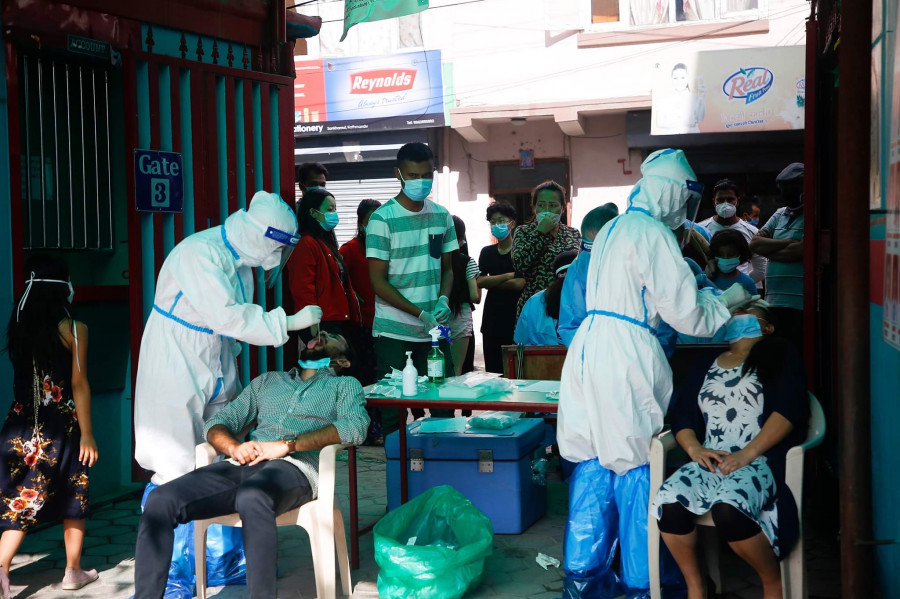Health
Contact tracing is key, but a lack of human resource is making it ineffective
As virus cases rise, public health experts say authorities must mobilise more people to do the job–and they don't necessarily need to be health workers. College students, teachers and members of local clubs can do it.
Arjun Poudel
For the past few weeks, Gyan Bahadur Oli has been busy. An employee at the Urban Health Division of Kathmandu Metropolitan City, Oli is currently working as the Covid-19 focal person at the city office.
With the coronavirus cases rising at a rapid rate, especially after the lockdown was lifted, Oli’s working hours too have suddenly increased.
“My phone starts ringing as early as 5am, and at times, I work till 11pm,” said Oli.
As the only Covid-19 focal person for the Kathmandu metropolis, Oli has to manage teams that have been formed for contact tracing.
The city has formed five teams for contact tracing for Kathmandu’s 32 wards. Each team should consist of three members—a lab technician, a public health officer and a paramedic—as per the Health Ministry’s guidelines.
But there are only two people in a team due to the lack of personnel.
“As soon as details come to us, we activate our contact tracing team,” said Oli. “We try to contact the infected people by phone. But as cases are rising, contact tracing is becoming difficult. And we don't have enough people."
As of Tuesday, 608 people of the Kathmandu Metropolitan City have tested positive for the coronavirus.
That's a sudden surge and with just 10 people, Oli’s struggling.
Doctors say contact tracing is not only about finding the whereabouts of those who have tested positive but also about tracing all those who came in close contact with the infected within the last few days.
When details are provided to health workers tasked with contact tracing, they call up the infected people, inquire them about their health condition, ask about the number of people in their family, the number of people they have met in the past week, the places they have visited and the people who came in close contact with them.
With just a handful of people in the team, it is impossible to ask all those questions, according to Oli.
Narendra Bajracharya, chief of the Urban Health Division of the Kathmandu Metropolitan City, more than 100 people are needed to ensure contact tracing is done in an effective manner.
Doctors have for long been saying that contact tracing is the best tool to break the chain of transmission as the number of cases are rising and infections have been reported from all wards of Kathmandu.
“This pandemic cannot be controlled without making contact tracing effective and isolating the infected people,” Dr Bhagwan Koirala, chairman of Nepal Medical Council, a regulatory body of medical doctors, told the Post. “We have to put additional human resources in contact tracing immediately. If we keep depending on the existing manpower, we won’t be able to control the epidemic.”
Koirala estimates that at least 10,000 to 15,000 people should be mobilised for contact tracing across the country.
The Kathmandu Metropolitan City has formed contact tracing teams from among the health workers serving in its 27 urban health clinics. Each urban health clinic consists of two to three health workers.
Koirala, however, says it is not necessary to have health workers in the teams for contact tracing.
“College students and teachers, who have not been working for about five months now, social workers, female community health volunteers, members of local clubs and organisations can be mobilised for this,” said Koirala.
Since the coronavirus outbreak, public health experts worldwide have been emphasising testing, tracing and treating in isolation.
Nepal went into lockdown on March 24 when only two cases were reported, but by the time the government lifted the restrictions on July 21, the number of infections had crossed the 17,000 mark.
The number of Covid-19 cases started to rise at an alarming rate after the lockdown was lifted.
On Thursday, 525 people tested positive for the coronavirus. Of them 127 were from Kathmandu Valley.
The national Covid-19 tally has reached 24,957 with 1,577 in Kathmandu Valley.
With four deaths reported on Thursday, the Covid-19 toll has reached 95.
At a time when contact tracing should have been made more effective, the process actually is fraught with bureaucratic hassles, according to those involved.
According to Oli, the Covid-19 focal person for Kathmandu, when the Epidemiology and Disease Control Division sends details regarding contact tracing, they first have to go to the provincial health office, which then passes on the details to the district health office, which finally passses them on to the local government.
Once the local government teams like Oli’s complete contact tracing, the same labyrinthine process is followed in reverse until the Division gets the detailed information.
“Authorities have failed to recognise the importance of contact tracing in the fight against the coronavirus,” said Dr GD Thakur, former director at the Epidemiology and Disease Control Division. “Even after thousands of infections and nearly 100 deaths, we do not seem to be serious.”




 19.12°C Kathmandu
19.12°C Kathmandu














